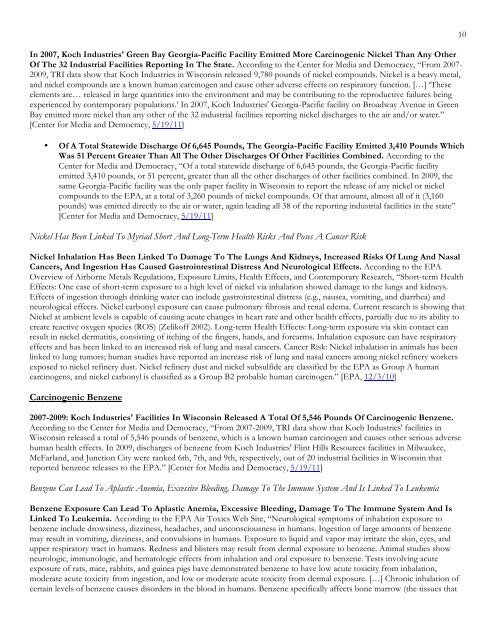Wisconsin-Report
Wisconsin-Report
Wisconsin-Report
Create successful ePaper yourself
Turn your PDF publications into a flip-book with our unique Google optimized e-Paper software.
In 2007, Koch Industries' Green Bay Georgia-Pacific Facility Emitted More Carcinogenic Nickel Than Any Other<br />
Of The 32 Industrial Facilities <strong>Report</strong>ing In The State. According to the Center for Media and Democracy, “From 2007-<br />
2009, TRI data show that Koch Industries in <strong>Wisconsin</strong> released 9,780 pounds of nickel compounds. Nickel is a heavy metal,<br />
and nickel compounds are a known human carcinogen and cause other adverse effects on respiratory function. […] ‘These<br />
elements are… released in large quantities into the environment and may be contributing to the reproductive failures being<br />
experienced by contemporary populations.’ In 2007, Koch Industries' Georgia-Pacific facility on Broadway Avenue in Green<br />
Bay emitted more nickel than any other of the 32 industrial facilities reporting nickel discharges to the air and/or water.”<br />
[Center for Media and Democracy, 5/19/11]<br />
• Of A Total Statewide Discharge Of 6,645 Pounds, The Georgia-Pacific Facility Emitted 3,410 Pounds Which<br />
Was 51 Percent Greater Than All The Other Discharges Of Other Facilities Combined. According to the<br />
Center for Media and Democracy, “Of a total statewide discharge of 6,645 pounds, the Georgia-Pacific facility<br />
emitted 3,410 pounds, or 51 percent, greater than all the other discharges of other facilities combined. In 2009, the<br />
same Georgia-Pacific facility was the only paper facility in <strong>Wisconsin</strong> to report the release of any nickel or nickel<br />
compounds to the EPA, at a total of 3,260 pounds of nickel compounds. Of that amount, almost all of it (3,160<br />
pounds) was emitted directly to the air or water, again leading all 38 of the reporting industrial facilities in the state”<br />
[Center for Media and Democracy, 5/19/11]<br />
Nickel Has Been Linked To Myriad Short And Long-Term Health Risks And Poses A Cancer Risk<br />
Nickel Inhalation Has Been Linked To Damage To The Lungs And Kidneys, Increased Risks Of Lung And Nasal<br />
Cancers, And Ingestion Has Caused Gastrointestinal Distress And Neurological Effects. According to the EPA<br />
Overview of Airborne Metals Regulations, Exposure Limits, Health Effects, and Contemporary Research, “Short-term Health<br />
Effects: One case of short-term exposure to a high level of nickel via inhalation showed damage to the lungs and kidneys.<br />
Effects of ingestion through drinking water can include gastrointestinal distress (e.g., nausea, vomiting, and diarrhea) and<br />
neurological effects. Nickel carbonyl exposure can cause pulmonary fibrosis and renal edema. Current research is showing that<br />
Nickel at ambient levels is capable of causing acute changes in heart rate and other health effects, partially due to its ability to<br />
create reactive oxygen species (ROS) (Zelikoff 2002). Long-term Health Effects: Long-term exposure via skin contact can<br />
result in nickel dermatitis, consisting of itching of the fingers, hands, and forearms. Inhalation exposure can have respiratory<br />
effects and has been linked to an increased risk of lung and nasal cancers. Cancer Risk: Nickel inhalation in animals has been<br />
linked to lung tumors; human studies have reported an increase risk of lung and nasal cancers among nickel refinery workers<br />
exposed to nickel refinery dust. Nickel refinery dust and nickel subsulfide are classified by the EPA as Group A human<br />
carcinogens, and nickel carbonyl is classified as a Group B2 probable human carcinogen.” [EPA, 12/3/10]<br />
Carcinogenic Benzene<br />
2007-2009: Koch Industries' Facilities In <strong>Wisconsin</strong> Released A Total Of 5,546 Pounds Of Carcinogenic Benzene.<br />
According to the Center for Media and Democracy, “From 2007-2009, TRI data show that Koch Industries' facilities in<br />
<strong>Wisconsin</strong> released a total of 5,546 pounds of benzene, which is a known human carcinogen and causes other serious adverse<br />
human health effects. In 2009, discharges of benzene from Koch Industries' Flint Hills Resources facilities in Milwaukee,<br />
McFarland, and Junction City were ranked 6th, 7th, and 9th, respectively, out of 20 industrial facilities in <strong>Wisconsin</strong> that<br />
reported benzene releases to the EPA.” [Center for Media and Democracy, 5/19/11]<br />
Benzene Can Lead To Aplastic Anemia, Excessive Bleeding, Damage To The Immune System And Is Linked To Leukemia<br />
Benzene Exposure Can Lead To Aplastic Anemia, Excessive Bleeding, Damage To The Immune System And Is<br />
Linked To Leukemia. According to the EPA Air Toxics Web Site, “Neurological symptoms of inhalation exposure to<br />
benzene include drowsiness, dizziness, headaches, and unconsciousness in humans. Ingestion of large amounts of benzene<br />
may result in vomiting, dizziness, and convulsions in humans. Exposure to liquid and vapor may irritate the skin, eyes, and<br />
upper respiratory tract in humans. Redness and blisters may result from dermal exposure to benzene. Animal studies show<br />
neurologic, immunologic, and hematologic effects from inhalation and oral exposure to benzene. Tests involving acute<br />
exposure of rats, mice, rabbits, and guinea pigs have demonstrated benzene to have low acute toxicity from inhalation,<br />
moderate acute toxicity from ingestion, and low or moderate acute toxicity from dermal exposure. […] Chronic inhalation of<br />
certain levels of benzene causes disorders in the blood in humans. Benzene specifically affects bone marrow (the tissues that<br />
10


